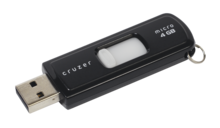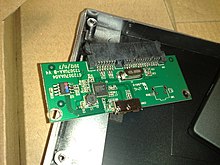USB Device classes
The functionality of USB devices is defined by class codes, communicated to the USB host to affect the loading of suitable software driver modules for each connected device. This provides for adaptability and device independence of the host to support new devices from different manufacturers.
Device classes include:
| Class | Usage | Description | Examples, or exception |
|---|---|---|---|
| 00h | Device | Unspecified | Device class is unspecified, interface descriptors are used to determine needed drivers |
| 01h | Interface | Audio | Speaker, microphone, sound card, MIDI |
| 02h | Both | Communications and CDC Control | Modem, Ethernet adapter, Wi-Fi adapter |
| 03h | Interface | Human interface device (HID) | Keyboard, mouse, joystick |
| 05h | Interface | Physical Interface Device (PID) | Force feedback joystick |
| 06h | Interface | Image | Webcam, scanner |
| 07h | Interface | Printer | Laser printer, inkjet printer, CNC machine |
| 08h | Interface | Mass storage (MSC or UMS) | USB flash drive, memory card reader, digital audio player, digital camera, external drive |
| 09h | Device | USB hub | Full bandwidth hub |
| 0Ah | Interface | CDC-Data | Used together with class 02h: communications and CDC control |
| 0Bh | Interface | Smart Card | USB smart card reader |
| 0Dh | Interface | Content security | Fingerprint reader |
| 0Eh | Interface | Video | Webcam |
| 0Fh | Interface | Personal Healthcare | Pulse monitor (watch) |
| 10h | Interface | Audio/Video (AV) | Webcam, TV |
| DCh | Both | Diagnostic Device | USB compliance testing device |
| E0h | Interface | Wireless Controller | Bluetooth adapter, Microsoft RNDIS |
| EFh | Both | Miscellaneous | ActiveSync device |
| FEh | Interface | Application-specific | IrDA Bridge, Test & Measurement Class (USBTMC),USB DFU (Direct Firmware Update) |
| FFh | Both | Vendor-specific | Indicates that a device needs vendor-specific drivers |
USB mass storage / USB drive
See also: USB mass storage device class, Disk enclosure and External hard disk drive
USB implements connections to storage devices using a set of standards called the USB mass storage device class (MSC or UMS). This was at first intended for traditional magnetic and optical drives and has been extended to support flash drives. It has also been extended to support a wide variety of novel devices as many systems can be controlled with the familiar metaphor of file manipulation within directories. The process of making a novel device look like a familiar device is also known as extension. [citation needed] The ability to boot a write-locked SD card with a USB adapter is particularly advantageous for maintaining the integrity and non-corruptible, pristine state of the booting medium.

A flash drive, a typical USB mass-storage device

Circuit board from a USB 3.0 external 2.5-inch SATA HDD enclosure
Though most post-Summer 2004 computers can boot from USB mass storage devices, USB is not intended as a primary bus for a computer's internal storage. Buses such as Parallel ATA (PATA or IDE), Serial ATA (SATA), or SCSI fulfill that role in PC class computers. However, USB has one important advantage, in that it is possible to install and remove devices without rebooting the computer (hot-swapping), making it useful for mobile peripherals, including drives of various kinds.
Firstly conceived and still used today for optical storage devices (CD-RW drives, DVD drives, etc.), several manufacturers offer external portable USB hard disk drives, or empty enclosures for disk drives. These offer performance comparable to internal drives, limited by the current number and type of attached USB devices, and by the upper limit of the USB interface (in practice about 30 MB/s for USB 2.0 and potentially 400 MB/s or more for USB 3.0). These external drives typically include a "translating device" that bridges between a drive's interface to a USB interface port. Functionally, the drive appears to the user much like an internal drive. Other competing standards for external drive connectivity include eSATA, ExpressCard (now at version 2.0), FireWire (IEEE 1394), and most recently Thunderbolt.
Another use for USB mass storage devices is the portable execution of software applications (such as web browsers and VoIP clients) with no need to install them on the host computer.
Media Transfer Protocol
Media Transfer Protocol (MTP) was designed by Microsoft to give higher-level access to a device's filesystem than USB mass storage, at the level of files rather than disk blocks. It also has optional DRM features. MTP was designed for use with portable media players, but it has since been adopted as the primary storage access protocol of the Android operating system from the version 4.1 Jelly Bean as well as Windows Phone 8 (Windows Phone 7 devices had used the Zune protocol which was an evolution of MTP). The primary reason for this is that MTP does not require exclusive access to the storage device the way UMS does, alleviating potential problems should an Android program request the storage while it is attached to a computer. The main drawback is that MTP is not as well supported outside of Windows operating systems.
Human interface devices
Main article: USB human interface device class
Joysticks, keypads, tablets and other human-interface devices (HIDs) are also progressively migrating from MIDI, and PC game port connectors to USB.
USB mice and keyboards can usually be used with older computers that have PS/2 connectors with the aid of a small USB-to-PS/2 adapter. For mice and keyboards with dual-protocol support, an adaptor that contains no logic circuitry may be used: the hardware in the USB keyboard or mouse is designed to detect whether it is connected to a USB or PS/2 port, and communicate using the appropriate protocol. Converters also exist that connect PS/2 keyboards and mice (usually one of each) to a USB port. These devices present two HID endpoints to the system and use a microcontroller to perform bidirectional data translation between the two standards.